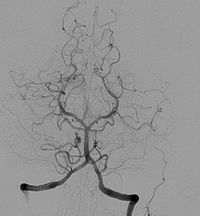
Appearance of Polypoidal Lesions in Patients With Polypoidal Choroidal Vasculopathy Using Swept-Source Optical Coherence Tomographic Angiography.
Sign Up to like & getrecommendations! Published in 2019 at "JAMA ophthalmology"
DOI: 10.1001/jamaophthalmol.2019.0449
Abstract: Importance Polypoidal choroidal vasculopathy (PCV) is a major cause of visual loss worldwide, particularly in Asia, and the appropriate understanding of the structures in PCV previously described as polypoidal lesions is important for understanding their… read more here.
Keywords: using swept; angiography; swept source; polypoidal lesions ... See more keywords

Use of 3‐D digital subtraction rotational angiography during cardiac catheterization of infants and adults with congenital heart diseases
Sign Up to like & getrecommendations! Published in 2017 at "Catheterization and Cardiovascular Interventions"
DOI: 10.1002/ccd.27180
Abstract: To compare image quality, radiation and contrast doses required to obtain 3D‐Digital subtraction rotational angiography (3D‐DSRA) with 3D‐Digital rotational angiography (3D‐DRA) in infants (children ≤ 2 years of age) and adults with congenital heart diseases (ACHD). read more here.
Keywords: rotational angiography; congenital heart; angiography; digital subtraction ... See more keywords

Focused update of expert consensus statement: Use of invasive assessments of coronary physiology and structure: A position statement of the society of cardiac angiography and interventions
Sign Up to like & getrecommendations! Published in 2018 at "Catheterization and Cardiovascular Interventions"
DOI: 10.1002/ccd.27672
Abstract: The rationale for adjunctive intracoronary diagnostic techniques is to supplement coronary angiography, the traditional method for determining the severity of coronary stenoses [1,2]. The purpose of this Focused Update is to incorporate the latest clinical… read more here.
Keywords: position statement; focused update; angiography; physiology ... See more keywords

Planning percutaneous coronary interventions using computed tomography angiography and fractional flow reserve‐derived from computed tomography: A state‐of‐the‐art review
Sign Up to like & getrecommendations! Published in 2019 at "Catheterization and Cardiovascular Interventions"
DOI: 10.1002/ccd.27817
Abstract: Fractional flow reserve derived by coronary computed tomography angiography (CTA; FFRCT) is an accurate noninvasive method for identifying coronary artery disease (CAD) and detecting hemodynamically significant stenosis. Although initially proposed as noninvasive tools to “rule… read more here.
Keywords: computed tomography; fractional flow; angiography; flow reserve ... See more keywords

Hydraulic stimulation of carotid artery baroreceptors as a likely cause of transient asystolic cardiac arrest during diagnostic angiography or surgical endarterectomy
Sign Up to like & getrecommendations! Published in 2019 at "Catheterization and Cardiovascular Interventions"
DOI: 10.1002/ccd.28126
Abstract: We describe two patients—both who underwent general anesthesia—in whom we theorize that hydraulic pressure on carotid artery baroreceptors resulted in transient asystolic cardiac arrest (TACA) during diagnostic or therapeutic procedures. Patient #1 was a 58‐year‐old… read more here.
Keywords: artery baroreceptors; carotid artery; carotid; angiography ... See more keywords

Angiography versus FFR guided complete revascularization versus culprit‐only revascularization for patients presenting with STEMI: Network meta‐analysis
Sign Up to like & getrecommendations! Published in 2022 at "Catheterization and Cardiovascular Interventions"
DOI: 10.1002/ccd.30304
Abstract: This study aimed to compare the outcomes of different revascularization strategies among patients presenting with ST‐segment elevation myocardial infarction (STEMI) and multivessel coronary artery disease (MVD) undergoing primary percutaneous coronary intervention (PCI). MVD is present… read more here.
Keywords: angiography; patients presenting; angiography guided; ffr guided ... See more keywords

Optical coherence tomography versus angiography and intravascular ultrasound to guide coronary stent implantation: A systematic review and meta‐analysis
Sign Up to like & getrecommendations! Published in 2022 at "Catheterization and Cardiovascular Interventions"
DOI: 10.1002/ccd.30416
Abstract: Optical coherence tomography (OCT) is an adjunct to angiography‐guided coronary stent placement. However, in the absence of dedicated, appropriately powered randomized controlled trials, the impact of OCT on clinical outcomes is unclear. read more here.
Keywords: coherence tomography; coronary stent; optical coherence; angiography ... See more keywords

Coronary angiography of the ex‐situ beating donor heart in a portable organ care system
Sign Up to like & getrecommendations! Published in 2022 at "Catheterization and Cardiovascular Interventions"
DOI: 10.1002/ccd.30455
Abstract: To determine safety and feasibility of ex‐situ coronary angiography. read more here.
Keywords: angiography; situ beating; coronary angiography; donor heart ... See more keywords

Pre‐stenting angiography‐FFR based physiological map provides virtual intervention and predicts physiological and clinical outcomes
Sign Up to like & getrecommendations! Published in 2023 at "Catheterization and Cardiovascular Interventions"
DOI: 10.1002/ccd.30635
Abstract: Angiography‐derived fractional flow reserve (FFR) (angio‐FFR) has been validated against FFR and could provide virtual pullback. However, whether a physiological map can be generated by angio‐FFR and its clinical value remains unclear. We aimed to… read more here.
Keywords: clinical outcomes; angiography; physiological clinical; physiological map ... See more keywords

Atherosclerosis Imaging Quantitative Computed Tomography (AI‐QCT) to guide referral to invasive coronary angiography in the randomized controlled CONSERVE trial
Sign Up to like & getrecommendations! Published in 2023 at "Clinical Cardiology"
DOI: 10.1002/clc.23995
Abstract: We compared diagnostic performance, costs, and association with major adverse cardiovascular events (MACE) of clinical coronary computed tomography angiography (CCTA) interpretation versus semiautomated approach that use artificial intelligence and machine learning for atherosclerosis imaging‐quantitative computed… read more here.
Keywords: angiography; computed tomography; imaging quantitative; tomography ... See more keywords

Automated quantification of superficial retinal capillaries and large vessels for diabetic retinopathy on optical coherence tomographic angiography.
Sign Up to like & getrecommendations! Published in 2019 at "Journal of biophotonics"
DOI: 10.1002/jbio.201900103
Abstract: Optical coherence tomography angiography (OCTA) is a relatively new technique with capillary-level resolution, which has shown great potential for the diagnosis of diabetic retinopathy (DR). A fully automatic algorithm for the quantitative measurement of microcirculatory… read more here.
Keywords: optical coherence; diabetic retinopathy; large vessels; angiography ... See more keywords